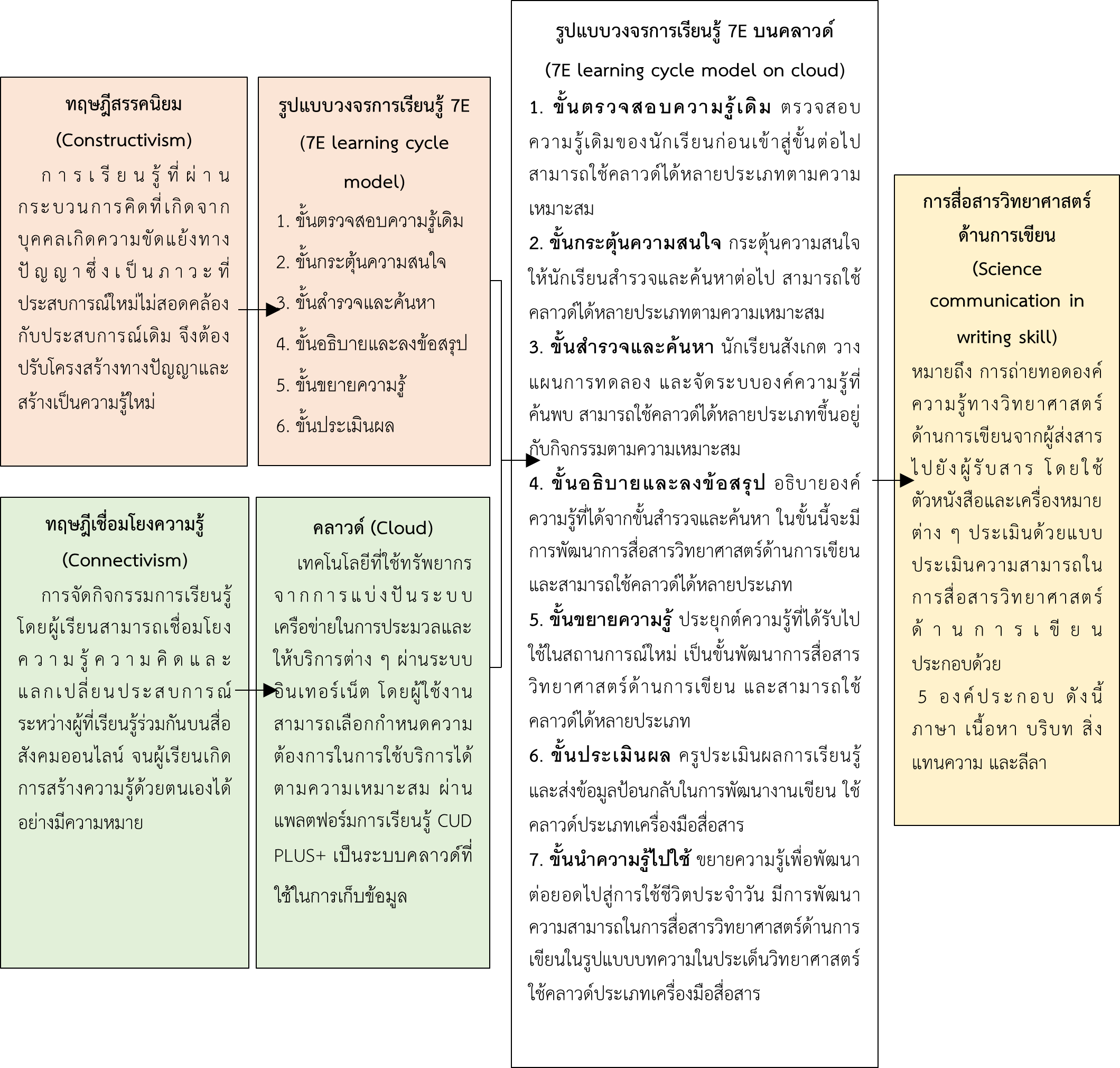The Effects of Implementing the 7E Learning Cycle Model on Cloud to promote Science Communication and Writing Ability among High School Students under the Ministry of Higher Education, Science, Research and Innovation
DOI:
https://doi.org/10.14456/educu.2024.25Keywords:
Science communication, 7E Learning cycle model, cloudAbstract
This research aims to: 1) study the science communication and writing abilities of high school students after learning through the 7E learning cycle model on a cloud platform, and 2) compare the science communication and writing ability of students before, during, and after learning through the 7E learning cycle model on a cloud platform. The samples consisted of 30 tenth-grade students at a university demonstration school selected using purposive sampling.The research instruments included lesson plans utilizing the 7E learning cycle model on a cloud platform, and science communication and writing ability assessment forms. The collected data were analyzed using arithmetic mean, standard deviation, t-test, and repeated measure ANOVA. The results of this research are summarized as follows: 1) After the experiment, the student’s abilities in science communication and writing ability were determined to be at a good level, with every component found to be at a good level. Language proficiency achieved the highest average score, followed by the content, style, context and representation. 2)The students’ science communication and writing ability were higher than before the experiment at the .05 level of significance, and the student’s abilities in science communication and writing ability were higher than the second in-process evaluation, the first in-process evaluation, and before the experiment.
References
ภาษาไทย
กุลชัย กุลตวนิช. (2557). ระบบการเรียนบนห้องเรียนเสมือนแบบคลาวด์ตามแนวคิดการเรียนรู้คอนเน็คติวิสม์เพื่อส่งเสริมการรู้สารสนเทศและการรับรู้ความสามารถของตนเองด้านการรู้สารสนเทศสำหรับนิสิตนักศึกษาปริญญาตรี [วิทยานิพนธ์ปริญญาดุษฎีบัณฑิต]. Chulalongkorn University Intellectual Repository (CUIR). https://cuir.car.chula.ac.th/handle/123456789/46017
กระทรวงศึกษาธิการ. (2557). คู่มือประเมินสมรรถนะสำคัญของผู้เรียนระดับการศึกษาขั้นพื้นฐานตามหลักสูตรแกนกลางการศึกษาขั้นพื้นฐาน พุทธศักราช 2551 ชั้นมัธยมศึกษาปีที่ 6. โรงพิมพ์ชุมนุมสหกรณ์การเกษตรแห่งประเทศไทย จำกัด.
ญาสุมิน วรกิจจานนท์. (2563). การพัฒนาความสามารถในการสื่อสารวิทยาศาสตร์ด้านการเขียนของนักเรียนชั้นมัธยมศึกษาปีที่ 5 ในหน่วยการเรียนรู้เรื่อง ระบบย่อยอาหาร โดยใช้การจัดการเรียนรู้แบบสืบเสาะหาความรู้ที่ใช้แบบจำลองเป็นฐาน. การประชุมวิชาการเสนอผลงานวิจัยระดับบัณฑิตศึกษาแห่งชาติ ครั้งที่ 21. https://app.gs.kku.ac.th/images/img/support/grc2020/pdfabstracts//HMO8.pdf
ธนกร อรรจนาวัฒน์. (2558). การพัฒนาความสามารถในการสื่อสารวิทยาศาสตร์และการทำงานเป็นทีมโดยใช้การจัดการเรียนรู้แบบแสวงหาความรู้เป็นกลุ่มของนักเรียนชั้นมัธยมศึกษาศึกษาปีที่ 5 [วิทยานิพนธ์ปริญญามหาบัณฑิต, จุฬาลงกรณ์มหาวิทยาลัย]. Chulalongkorn University Intellectual Repository (CUIR). https://cuir.car.chula.ac.th/bitstream/123456789/51076/1/5783439627.pdf
ธาดาพนิตสดี ศุกลวิริยะกุล. (2560). ผลของการเรียนรู้แบบโมบายเลิร์นนิงบนคลาวด์ร่วมกับ 4Ex2 ที่มีต่อความสามารถในการแก้ปัญหาคณิตศาสตร์ของนักเรียนชั้นมัธยมศึกษาปีที่ 1 [วิทยานิพนธ์ปริญญามหาบัณฑิต, จุฬาลงกรณ์มหาวิทยาลัย]. Chulalongkorn University Intellectual Repository (CUIR).
https://cuir.car.chula.ac.th/bitstream/123456789/58433/1/5883347627.pdf
ปฐมสุดา อินทุประภา. (2562). การสื่อสารวิทยาศาสตร์ในบริบทนักวิทย์ไทย. https://oer.learn.in.th/search_detail/result/140358
ปณาลี สติคราม. (2562). การพัฒนาความสามารถในการเขียนสื่อสารวิทยาศาสตร์ของนักเรียนมัธยมศึกษาตอนปลายโดยใช้การจัดการเรียนรู้แบบสืบสอบ ร่วมกับการเขียนแบบร่วมมือรวมพลัง [วิทยานิพนธ์ปริญญามหาบัณฑิต, จุฬาลงกรณ์มหาวิทยาลัย]. Chulalongkorn University Intellectual Repository (CUIR). http://cuir.car.chula.ac.th/handle/123456789/78023
พัทธมน วิริยะธรรม. (2561). การพัฒนาผลสัมฤทธิ์ทางการเรียนและความสามารถในการแก้โจทย์ปัญหาเรื่อง ปริมาณสารสัมพันธ์ ของนักเรียนชั้นมัธยมศึกษาปีที่ 4 โดยใช้รูปแบบการสอนแบบ วัฏจักรการเรียนรู้ 7E ร่วมกับเทคนิค KWDL. วารสารศึกษาศาสตร์ มหาวิทยาลัยนเรศวร, 20(2), 140-152.
ศศิเทพ ปิติพรเทพิน. (2557). วิทยาศาสตร์กับการสื่อสาร. บริษัท เอพริน เรน พริ้นติ้ง จำกัด.
ศุจิกา จาตุรนต์พงศา. (2557). ผลของการใช้รูปแบบวงจรการเรียนรู้ 5E ร่วมกับสัญศาสตร์ที่มีต่อความเข้าใจคำศัพท์ชีววิทยาและผลสัมฤทธิ์ทางการเรียนของนักเรียนมัธยมศึกษาตอนปลาย. [วิทยานิพนธ์ปริญญามหาบัณฑิต, จุฬาลงกรณ์มหาวิทยาลัย]. Chulalongkorn University Intellectual
Repository (CUIR). http://cuir.car.chula.ac.th/handle/123456789/46013
ศูนย์ดำเนินงาน PISA แห่งชาติ สถาบันส่งเสริมการสอนวิทยาศาสตร์และเทคโนโลยี. (2567). ผลการประเมิน PISA 2022 : บทสรุปสำหรับผู้บริหาร. สถาบันส่งเสริมการสอนวิทยาศาสตร์และเทคโนโลยี (สสวท.).
สถาบันส่งเสริมการสอนวิทยาศาสตร์และเทคโนโลยี. (2546). คู่มือวัดและประเมินผลวิทยาศาสตร์. สถาบันส่งเสริมการสอนวิทยาศาสตร์และเทคโนโลยี (สสวท.).
ภาษาอังกฤษ
Aaron, L. S., & Roche, C. M. (2012). Teaching, learning, and collaborating in the cloud: Applications of cloud computing for educators in post-secondary institutions. Journal of Educational Technology Systems, 40(2), 95-111. https://www.learntechlib.org/p/72138/
Bybee, R. W., Taylor, J. A., Gardner, A., Van Scotter, P., Powell, J. C., Westbrook, A., & Landes, N. (2006). The BSCS 5E instructional model: Origins and effectiveness. Colorado Springs, Co: BSCS, 5, 88-98.
Eisenkraft, A. (2003). Expanding the 5E Model: A Proposed 7E Model emphasizes “Transfer of Learning” and the importance of Eliciting Pior Understanding. The Science Teacher, 70(6). 56-59.
Kulgemeyer, C., & Schecker, H. (2013). Students explaning science – assessment pf science communication competence. Research in Science Education. 43(6), 2235-2256.
Lubiano, M. L. D., & Magpantry, M. S. (2021). Enhanced 7E Instructional Model towards enriching science inquiry skills. International Journal of Research in Education and Science (IJRES), 7(3), 630-658. https://doi.org/10.46328/ijres.1963
Mapstone, L. M., & Kuchel, L. (2017). Core skills for effective science communication: A teaching resource for undergraduate science education. International Journal of Science Education, Part B: Communication and Public Engagement, 7(2), 181-201. https://doi.org/10.1080/21548455.2015.1113573
Metusalem, R., Belenky, D., & DiCerbo, K. (2017). Skills for today: what we know about teaching
and assessing communication. In: London: Pearson.
O’Hair, D., Wiemann, M., Mullin, D. I., & Teven, J. (2021). Real communication: An introduction (5th edition). Boston, MA: Bedford/St. Martin’s.
TeachThought. (2012). 4 Benefits to Cloud-Based Lerning. http://www.teachthought.com/technology/4-benefits-to-cloud-based-learning
Tsabari B. & Lewenstein, B. V. (2013). An instruments for assessing Scientists’ Written skills in Public Communication of science. Science Communication, 35(1), 56-85.
Ullman, D. F., & Haggerty, B. (2010). Embracing the Cloud: Six ways to look at the shift to Cloud Computing. Educause Quarterly, 33(2), n2.
Wodaj, H., & Belay, S. (2021). Effects of 7E instructional model with metacognitive scaffolding on student’s conceptual understanding in biology. Journal of Education in Science, Environment and Health (JESEH), 7(1), 26-43. https://doi.org/10.21891/jeseh.770794

Downloads
Published
How to Cite
Issue
Section
License

This work is licensed under a Creative Commons Attribution-NonCommercial-NoDerivatives 4.0 International License.



